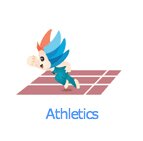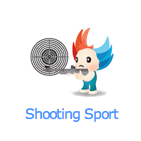Athletics

Athletics consist of the most basic human movements such as running, jumping, and throwing, which have existed since the birth of mankind. In other words, running, jumping, and throwing were a means of survival and it can be presumed that these movement became competitive sports over time with rules and various events.
Total days of play :6days
Events
24 Men’s events
Track (12) : 100m, 200m, 400m, 800m, 1500m, 5000m, 10000m, 110mH, 400mH, 4×100m, 4×400m,
3000m Steeplechase
Jump (4) : High Jump, Long Jump, Triple Jump, Pole Vault
Throw (4) : Discus, Javelin, Shot Put, Hammer Throw
Road Race (3) : 20km Race Walking, Half Marathon, Half Marathon Team
Combined Event (1) : Decathlon
24 Women’s events
Track (12) : 100m, 200m, 400m, 800m, 1500m, 5000m, 10000m, 100mH, 400mH, 4×100m, 4×400m,
3000m Steeplechase
Jump (4) : High Jump, Long Jump, Triple Jump, Pole Vault
Throw (4) : Discus, Javelin, Shot Put, Hammer Throw
Road Race (3) : 20km Race Walking, Half Marathon, Half Marathon Team
Combined Event (1) : Heptathlon
Rules
| Category | Event | Gender | Rules | |
| Track | Sprints | 100m | M,W | Competitors run 100m of straight line in pre-assigned lanes. |
| 200m | M,W | Competitors run 120m of curved line and 80m of straight line in pre-assigned lanes. | ||
| 400m | M,W | Competitors run 400m consisting of two 120m curved lines and two 80m straight lines in pre-assigned lanes. | ||
| Middle-distance | 800m | M,W | Competitors run 2 laps around a 400m track in pre-assigned lanes for the first 120m and then in shared lanes for the remaining course. | |
| 1,500m | M,W | Competitors run 3 and 3/4 laps around a 400m track in shared lanes from the starting line at the back stretch. | ||
| Long-distance | 5,000m | M,W | Competitors run 12 and 1/2 laps around a 400m track in shared lanes. | |
| 10,000m | M,W | Competitors run 25 laps around a 400m track in shared lanes. | ||
| Hurdles | 100mH | W | Competitors jump over 10 hurdles (83.8cm high, placed 8.5m apart) in pre-assigned lanes. | |
| 110mH | M | Competitors jump over 10 hurdles (106.7cm high, placed 9.14m apart) in pre-assigned lanes. | ||
| 400mH | M,W | Competitors jump over 10 hurdles (91.4cm high for men, 76.2cm high for women, placed 35m apart) in pre-assigned lanes with a staggered start. | ||
| Steeplechase | 3000mSC | M,W | Competitors clear 28 barriers (91.4cm high for men, 76.2cm for women) and 7 water jumps, running 7 and 1/2 laps around a 400m track. | |
| Relays | 4×100m R | M,W | Competitors form a team of four and pass the baton in relay. Each competitor runs 100m in pre-assigned lanes and passes the baton in the passing zone. *Baton: ∅ 38mm, L 30cm | |
| 4×400m R | M,W | Competitors form a team of four and pass the baton in relay. Each competitor runs 400m and passes the baton in the passing zone. Once the second runner crosses the break line, competitors run in shared lanes. | ||
| Field | Jumps | High jump | M,W | Competitors jump over a horizontal bar. (3 attempts) |
| Pole vault | M,W | Competitors use a pole to jump over the bar after the approach. (3 attempts) | ||
| Long jump | M,W | Competitors jump after running and stepping on the board with one foot. | ||
| Triple jump | M,W | Competitors use the acceleration from the approach to hop, step and jump, and total distance is measured. (3 attempts. 6 attempts if less than 8 competitors) | ||
| Field | Throws | Shot put | M,W | Competitors throw the shot from inside a circle of 2.135m. Men’s shot weighs over 7.257kg with diameter 110-130mm. Women’s shot weighs over 4kg with diameter 95-110. (3 attempts) |
| Discus | M,W | Competitors use the centrifugal force of the spin to throw the discus from inside a circle of 2.5m. (3 attempts) | ||
| Hammer throw | M,W | Competitors spin the spherical hammer connected to a triangular handle via a steel wire using the centrifugal force of the spin from inside a circle of 2.135m. (3 attempts) | ||
| Javelin | M,W | Competitors throw the spear after running a distance of less than 35m. Men’s spear measures 2.6~2.7m and weighs 800g. Women’s spear measures 2.2~2.3m and weighs 600g. (6 attempts) | ||
| Combined Events | Heptathlon | W | Seven events are held over two consecutive days and competitors are ranked according to the total number of points earned. Events are held in the order below.Day 1 : 100mH, shot put, high jump, 200mDay 2 : long jump, javelin, 800m | |
| Decathlon | M | Ten events are held over two consecutive days and competitors are ranked according to the total number of points earned. Events are held in the order below.Day 1 : 100m, long jump, shot put, high jump, 400mDay 2 : 110mH. discus, pole vault, javelin, 1,500m | ||
| Road Race | Race walking | M,W | Competitors advance with one foot always in contact with the ground.20km race walk : road loopback course, 10km each way | |
| Half marathon | M,W | Competitors run a 21.0975km loopback course through the city, with start and finish lines at the main stadium as far as possible. | ||
History
In Ancient Greece, games were held as religious festivals in front of temples. The most well known are Games held at Olympia around 776 B.C. called “Olympias” which included the stade race (sprint), dolichos (long-distance race), ancient pentathlon, and discus throw.
Modern games were held for prize money starting in 7th century. The games began to grow in scale as aristocrats fought over strong players in order to win the prize.
In the 18th century, various races were held in public roads without any designated venues. The growing demand by spectators to see the races led to the current format in which the players run around the venue.
In addition to long distance races, relatively short races such as the 1 mile, half mile, and 100 yard races began to emerge.
Athletics was first introduced in Korea in 1869 by a teacher from England named Hutchinson. The Korean Olympic Committee was established in 1920, laying the foundation for future development of Korean athletics, and the first athletics competition was held in 1929
Facilities
2013 MEDAL COUNT
11 14 15
Future Universiades and USA Organizers






©Copyright 2015























